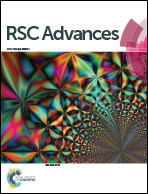Nanosorbcats of methylene blue on novel Fe2O3 nanorods for photocatalytic water oxidation†
Abstract
The development of dye-loaded nanosorbcats can make best use of their advantages in removing dyes from wastewater, also bypassing their disadvantages. Herein, functionalized Fe2O3 nano-rods (pfa@Fe2O3) were synthesized by using tween-80 induced assembly of pyrrol-2-methanoic acid (pfa) and iron(III) salts, and characterized by FT-IR, XRD, EPR, and SEM. The pfa@Fe2O3 nanorods’ adsorption capacity for methylene blue (MB) was 450 mg g−1 compared to only 39 mg g−1 for α-Fe2O3. Moreover, the kinetics to reach equilibrium were approximately 0.5 h and the pfa@Fe2O3 nanorods can be used as efficient recyclable adsorbents for MB. In particular, the MB loaded MB@pfa@Fe2O3–water system could also be used as dioxygen generator when irradiated with red LED light (10 W). The light induced intramolecular charge transfer between catalysts and photosensitizers was more efficient in the MB@pfa@Fe2O3/H2O system, and it exerted higher activity for water oxidation than the traditional catalyst/Ru(bpy)32+ system. Control experiment results suggested that the α-Fe2O3 can’t be used as LED light driven catalysts for water oxidation. In conclusion, the MB@pfa@Fe2O3 nanorods were efficient recyclable nanosorbcats for LED-light-driven dioxygen generation using water as oxygen source.


 Please wait while we load your content...
Please wait while we load your content...